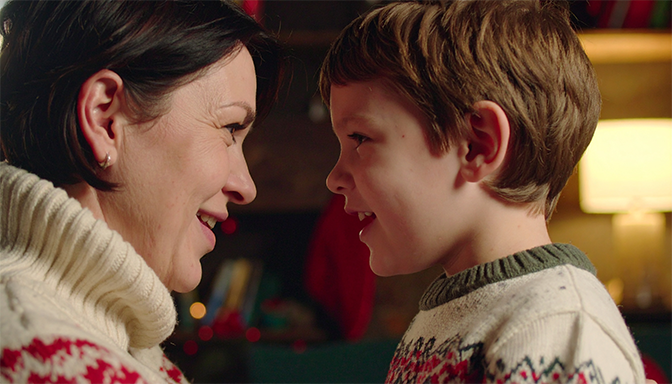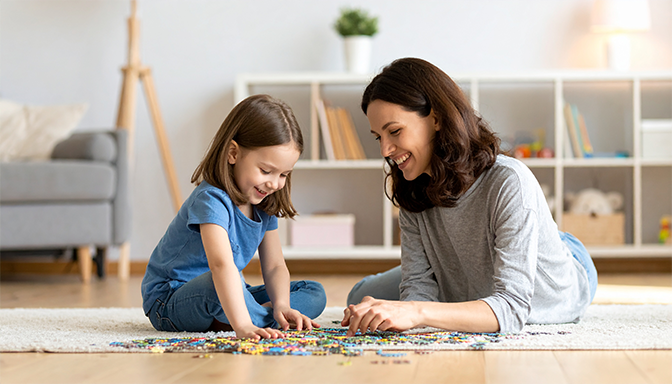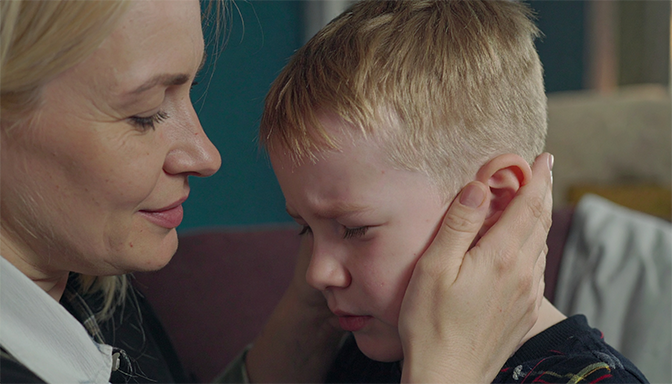7 Ways to Build Strong Emotional Connections with Your Kids (At Any Age)
7 Ways to Build Strong Emotional Connections with Your Kids (At Any Age)
That moment when your child opens up to you about something important – a friendship drama, a fear they’ve been carrying, or a dream they’re afraid to share – feels like pure magic. You’re reminded that beneath all the daily logistics of parenting (the nagging about homework, negotiating screen time, and managing bedtime routines), there’s this incredible little person who trusts you enough to share their inner world. These moments of genuine connection are what make all the challenging parts of parenting worthwhile.
But here’s what’s frustrating: those beautiful connection moments can’t be forced or scheduled. You can’t demand that your 8-year-old share their deepest feelings over dinner, or expect your teenager to suddenly want heart-to-heart conversations just because you’re finally available to listen. Building emotional connections with children requires patience, consistency, and understanding that connection happens on their terms, not yours.
The good news is that emotional connection with children isn’t about having perfect parenting moments or deep conversations every day. It’s about creating an overall relationship environment where your kids feel safe, understood, and valued for who they are rather than just what they do. When children feel emotionally connected to their parents, they’re more likely to share problems when they arise, listen to guidance when they need it, and maintain close relationships into adulthood.
1. Listen to Understand Rather Than to Fix or Teach

The biggest barrier to emotional connection with children is the parental instinct to immediately solve problems, give advice, or turn every conversation into a teaching moment. When your child shares that someone was mean to them at school, your first impulse might be to offer solutions, ask probing questions to understand what really happened, or explain how they could handle the situation differently next time.
But what children often need most is simply to be heard and understood before they’re ready for solutions or lessons. When you listen with the goal of truly understanding their experience and feelings, you’re communicating that their emotions matter and that you’re a safe person to share with. This creates the foundation for deeper conversations and trust over time.
Listening to understand means reflecting back what you hear, asking gentle questions to learn more about their experience, and validating their feelings even when you don’t agree with their perspective or behavior. It means resisting the urge to immediately jump into problem-solving mode and instead creating space for your child to feel heard and supported.
Active Listening Strategies for Parents:
- Reflect back what you hear: “It sounds like you felt really left out when that happened”
- Ask open-ended questions: “Tell me more about what that was like for you”
- Validate emotions even when you disagree with behavior: “You were really angry, and that makes sense”
- Wait before offering solutions: “Do you want advice about this, or do you just need me to listen?”
- Put away distractions and give full attention when they’re sharing something important
- Use their language rather than immediately correcting or reframing their perspective
Creating Safe Emotional Space
When children feel heard and understood, they’re more likely to continue sharing their thoughts and feelings. If they sense that opening up always leads to lectures, solutions they didn’t ask for, or having their feelings dismissed, they’ll stop coming to you with the important stuff.
Focus on understanding their emotional experience first, then address any necessary problem-solving or guidance in separate conversations when they’re more receptive.
2. Follow Their Interests and Enter Their World

One of the most powerful ways to connect with children is to show genuine interest in the things that matter to them, even when those things seem silly, boring, or completely foreign to you. Whether your child is obsessed with dinosaurs, video games, sports, art, or collecting random objects, entering their world with curiosity and enthusiasm communicates that you value what they value.
This doesn’t mean you have to become an expert in every single thing your child enjoys, but it does mean paying attention to what lights them up and asking questions that show you care about their interests. When you spend time learning about their favorite subjects or participating in activities they love, you’re creating shared experiences and demonstrating that their passions matter to you.
Following their interests also provides natural opportunities for connection and conversation. It’s often easier for children to open up when they’re talking about something they love, and these conversations can naturally lead to deeper topics about their feelings, friendships, and experiences.
Interest-Based Connection Ideas:
- Ask genuine questions about their favorite books, games, shows, or hobbies
- Participate in activities they enjoy, even if they’re not your natural preference
- Learn basic information about their interests so you can have informed conversations
- Attend their games, performances, or events that matter to them
- Share their excitement when they want to show you something they’ve created or accomplished
- Remember details they’ve shared about their interests and follow up on them later
You can also invest in things like a Craft Kit or a Science Kit to help generate more interests and create more of these experiences.
Balancing Enthusiasm with Authenticity
The key is showing genuine interest rather than fake enthusiasm that children can easily detect. You don’t have to love everything your child loves, but you can appreciate their passion and learn enough to engage meaningfully with their interests.
When you authentically enter their world, children feel valued and understood, which creates natural opportunities for deeper emotional connection.
3. Create Regular One-on-One Time Without Distractions

In busy families, children often compete for parental attention and rarely get focused, uninterrupted time with their parents. Regular one-on-one time – even just 15-20 minutes of focused attention without siblings, phones, or other distractions – can significantly strengthen emotional connections and give children the individual attention they crave.
This dedicated time doesn’t need to involve special activities or cost money. It could be as simple as lying on their bed and talking before sleep, taking a walk around the neighborhood together, or spending time while they play and you give them your complete attention. The key is that it’s predictable, protected, and focused entirely on them.
During one-on-one time, let your child lead the conversation or activity. This isn’t time for addressing behavior issues, giving reminders about responsibilities, or asking about homework. It’s time for them to have your full, positive attention while doing something they enjoy or simply being together without agenda.
One-on-One Connection Strategies:
- Schedule regular individual time with each child, even if it’s brief
- Put away phones and other distractions during focused time together
- Let them choose the activity or conversation topic
- Avoid using this time for corrections, reminders, or difficult conversations
- Be fully present and engaged rather than multitasking
- Make this time consistent and reliable so children can count on it
Quality Over Quantity in Individual Attention
Fifteen minutes of completely focused, positive attention often creates more connection than hours of distracted time together. Children can tell when you’re truly present with them versus when you’re physically there but mentally elsewhere.
Consistency matters more than duration – regular brief connections are more valuable than occasional long periods of attention.
4. Share Your Own Stories and Emotions Appropriately

Children connect more deeply with parents who are willing to be vulnerable and share their own experiences and emotions in age-appropriate ways. This doesn’t mean burdening children with adult problems or using them as emotional support, but it does mean letting them see you as a complete person with feelings, struggles, and experiences rather than just an authority figure.
Sharing your own childhood stories, admitting when you make mistakes, and expressing your emotions in healthy ways teaches children that all feelings are normal and that you understand what it’s like to face challenges. When children see that you’ve experienced similar struggles or emotions, they feel less alone and more willing to share their own experiences.
This vulnerability also models emotional intelligence and healthy expression of feelings, which helps children develop their own emotional awareness and communication skills.
Appropriate Emotional Sharing:
- Share relevant childhood stories when they’re facing similar challenges
- Admit when you make mistakes and model how to apologize or make things right
- Express your emotions in healthy ways: “I’m feeling frustrated right now, so I need a few minutes to calm down”
- Talk about how you handle difficult emotions or stressful situations
- Share what you’re proud of, excited about, or grateful for in age-appropriate ways
- Acknowledge when you don’t know something or when you’re learning too
Maintaining Appropriate Boundaries
The goal is showing your humanity while still maintaining your role as the parent and protector. Share experiences and emotions that help your child understand that everyone faces challenges, but avoid sharing adult problems that would create anxiety or burden them with concerns they can’t handle.
Use your own emotional expression as teaching moments about healthy ways to process and communicate feelings.
5. Validate Their Feelings Even When You Disagree with Their Behavior

One of the most important skills for building emotional connection with children is learning to separate their feelings from their behavior. You can validate and understand your child’s emotions while still setting limits on inappropriate behavior. This approach helps children feel heard and supported while still learning important boundaries and expectations.
When children feel understood, they’re more likely to be cooperative and less likely to escalate emotional situations. Validation doesn’t mean agreeing with everything they do or feel, but it does mean acknowledging that their emotions make sense from their perspective and that all feelings are acceptable, even when all behaviors aren’t.
This skill is particularly important during difficult moments when children are upset, angry, or disappointed. Instead of dismissing their feelings or immediately focusing on behavior correction, start by acknowledging their emotional experience, then address any necessary behavior changes.
Emotion Validation Techniques:
- Acknowledge feelings before addressing behavior: “You’re really angry about this rule, and I understand that”
- Help them name emotions: “It looks like you’re feeling disappointed that we can’t go to the park today”
- Normalize difficult emotions: “It’s really hard when friends say mean things”
- Separate feelings from actions: “It’s okay to feel mad, but it’s not okay to hit your sister”
- Show empathy for their experience: “That sounds really frustrating”
- Avoid minimizing their emotions: “I know this feels really big to you right now”
Teaching Emotional Intelligence Through Validation
When you consistently validate your child’s emotions while maintaining appropriate boundaries around behavior, you’re teaching them that feelings are normal and manageable while actions have consequences. This helps them develop emotional intelligence and self-regulation skills.
Children who feel understood are more likely to listen to guidance and less likely to escalate emotional situations into power struggles.
6. Be Curious About Their Perspective Rather Than Assuming You Know What They’re Thinking

Children’s inner worlds are often much more complex than adults realize, and they frequently have thoughts, feelings, and motivations that differ from what parents assume. Building strong emotional connections requires approaching children with genuine curiosity about their perspective rather than making assumptions about what they’re thinking or feeling based on their behavior.
This means asking open-ended questions that invite them to share their thoughts and feelings rather than leading questions that guide them toward the answers you expect. It means being willing to be surprised by their responses and learning about who they are as individuals rather than just seeing them through the lens of your parental concerns.
Curiosity also involves asking about their experiences, opinions, and ideas on topics beyond just school and behavior. Children have thoughts about friendships, fairness, their future, their family, and the world around them that can provide insight into their personality and values.
Curiosity-Based Connection Questions:
- “What do you think about that?” instead of “Don’t you think you should…”
- “Help me understand why that’s important to you”
- “What was going through your mind when that happened?”
- “How did that make you feel?”
- “What would you do if you were in charge of this situation?”
- “What’s something I don’t know about you that you’d like me to know?”
Discovering Who They Really Are
When you approach children with genuine curiosity, you often discover aspects of their personality, intelligence, and character that surprise you. This deeper understanding strengthens your relationship and helps you parent more effectively because you’re responding to who they actually are rather than who you assume they are.
Curiosity also communicates respect for their individuality and encourages them to think critically about their own experiences and opinions.
7. Create Traditions and Rituals That Are Meaningful to Your Relationship

Shared traditions and rituals create ongoing opportunities for connection and give children positive experiences to anticipate and remember. These don’t need to be elaborate or expensive – simple, consistent traditions often become the most treasured memories and provide regular touchpoints for emotional connection.
Traditions can be seasonal (special holiday activities), weekly (pizza and movie nights), daily (bedtime stories or morning hugs), or milestone-based (special birthday traditions or celebration rituals). The key is that they’re meaningful to your specific relationship and provide opportunities for focused time together and positive shared experiences.
These rituals also create a sense of family identity and belonging that strengthens children’s emotional security and connection to you. When children know what to expect and have special experiences to look forward to, it creates stability and demonstrates that your relationship is a priority.
Meaningful Tradition Ideas:
- Special one-on-one breakfast dates on weekends or school holidays
- Bedtime rituals that include talking about the day’s highlights and challenges
- Annual traditions for birthdays, holidays, or the start of new school years
- Weekly family activities that everyone enjoys and participates in
- Special ways of celebrating achievements or milestones
- Unique family sayings, jokes, or activities that are just yours
Building Lasting Connection Through Consistency
The power of traditions lies in their consistency and the positive anticipation they create. Children remember the feeling of being prioritized and celebrated through these special times, and these memories often become the foundation of their adult relationship with you.
Focus on creating traditions that feel sustainable and enjoyable for your family rather than trying to replicate what other families do or what you think you should be doing.
Conclusion: Building Relationships That Last Beyond Childhood
Strong emotional connections with children aren’t built through perfect parenting moments or constant deep conversations. They’re built through consistent patterns of listening, understanding, showing interest, and demonstrating that your children are valued for who they are as individuals. When children feel emotionally connected to their parents, they develop better emotional intelligence, stronger self-esteem, and more resilient relationships throughout their lives.
Remember that building emotional connection is an ongoing process that looks different at every stage of your child’s development. The specific strategies that work will change as your children grow, but the underlying principles of listening, validating, showing interest, and spending focused time together remain constant.
The investment you make in emotional connection during childhood pays dividends throughout your lifelong relationship with your children. Adults who felt emotionally connected to their parents during childhood are more likely to maintain close relationships with them, seek their guidance during difficult times, and create strong family connections with their own children.
Of course, looking into parenting courses can be valuable in implementing any plan to get closer to your child and develop trust, boundaries, and emotional intelligence. Check out Raising Resilient Responsible Independent Children from Parenting Simply.
Your Emotional Connection Action Plan
- Listen to understand your child’s perspective before offering solutions or teaching moments
- Show genuine interest in their passions and activities, even when they differ from your own
- Create regular one-on-one time that’s focused entirely on them without distractions
- Share your own experiences and emotions in age-appropriate ways that help them feel less alone
- Validate their feelings consistently while maintaining appropriate boundaries around behavior
- Approach them with curiosity about who they are rather than assumptions about what they should be
- Create meaningful traditions and rituals that strengthen your unique relationship
Remember: Emotional connection with children is built through thousands of small interactions that communicate love, acceptance, and genuine interest in who they are. Focus on consistency and authenticity rather than perfection in your parenting approach.
Affiliate Disclaimer: Some links in this article may be affiliate links where a purchase would provide us with a commission. We only recommend products and services we truly believe can help you on your personal growth journey.
Advice Disclaimer: This advice is for informational and entertainment purposes only and not a substitute for professional counseling, therapy, financial, legal, or medical advice. You are responsible for your own decisions and actions. For serious issues, please consult qualified professionals.



